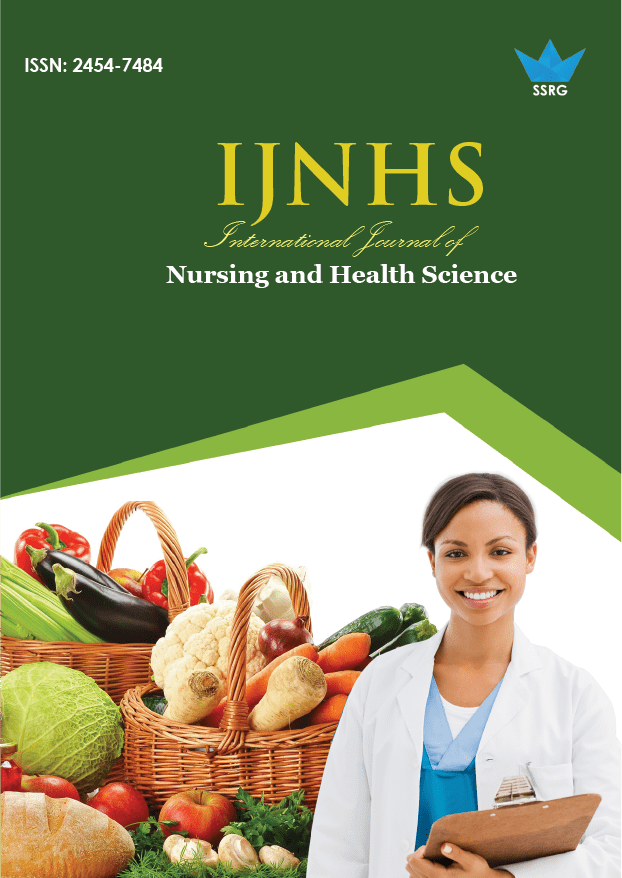Empowering Nurses in Clinical Decision Making (CDM) and Enhancing Covid-19 Patient’s Outcome Through Monitoring of Early Warning Score

| International Journal of Nursing and Health Science |
| © 2020 by SSRG - IJNHS Journal |
| Volume 6 Issue 2 |
| Year of Publication : 2020 |
| Authors : John Minimole, Pandey Captain Sandhya Shankar, Himanshi, Sebastian Susan, Jandu Navjyoti |
How to Cite?
John Minimole, Pandey Captain Sandhya Shankar, Himanshi, Sebastian Susan, Jandu Navjyoti, "Empowering Nurses in Clinical Decision Making (CDM) and Enhancing Covid-19 Patient’s Outcome Through Monitoring of Early Warning Score," SSRG International Journal of Nursing and Health Science, vol. 6, no. 2, pp. 23-26, 2020. Crossref, https://doi.org/10.14445/24547484/IJNHS-V6I2P105
Abstract:
A. Introduction: Today’s nurses are having challenges, demanding their ability to the profession during COVID-19 times. Nursing education should concentrate on educating competent health care providers to handle complex health care technology with fundamental implications for the latest generation of patients. Clinical decision-making (CDM) is a process that nurses use on a daily basis when they make a judgment about the issues related to patient care and management of COVID-19. The process of decision-making becomes increasingly intricate when nurses become more experienced as care providers. Nurses play a crucial role in clinical judgment in any developing health care system. Health promotion, protection from diseases, providing benefits to the patients, and resources of health care systems are allocated efficiently through the nurse's judgment and decision-making potential.
B. Methods: A quantitative approach, a descriptive study was taken to assess the knowledge and level of practice of staff nurses working in the COVID Units. A total of 130 staff nurses have participated in the study.
C. Results: There is a weak positive relationship (r= 0.347), i.e., p=0.01(p<0.05) existing between knowledge and practice regarding monitoring of early warning signs.
D. Conclusion: Clinical decision-making is an abstract skill that can be developed by using different strategies in different specialties and different situations. Since situational factors and time constraints are evident in practice, findings were supportive of clinical decision-making (CDM) skills. This study has provided a practical approach to train, teach, guide, and follow up regarding critical aspects of the clinical decision making for the patient’s care through monitoring of early warning score and appropriate action can be taken immediately. CDM is necessary for providing quality patient care and favoring patient satisfaction.
Keywords:
Clinical decision making (CDM), Early Warning Score, Staff Nurses, COVID-19
References:
[1] Abu‐Saad, H. H., & Hamers, J. P., Decision‐making and pediatric pain: a review, Journal of Advanced Nursing, 26(5) (1997) 946-952.
[2] Al Qadire, M., & Al Khalaileh, M., Jordanian nurses knowledge and attitude regarding pain management, Pain Management Nursing, 15(1) (2014) 220-228.
[3] Allen, G., Rubenfeld, M., & Scheffer, B., Reliability of assessment of critical thinking, Journal of Professional Nursing, 20 (2004) 15-22.
[4] Barlett, R., Bland, A., Rossen, E., Kautz, D., & Benfield, S. Evaluation of Outcome-Present State Test Model as a Way to Teach Clinical Decision Reasoning, Journal of Nursing Education, 47 (8) (2008) 337-344.
[5] Bittner, N. P., & Tobin, E., CRITICAL THINKING: Strategies for Clinical Practice, Journal for Nurses in Professional Development, 14(6) (1998) 267-272.
[6] Cader, R., Campbell, S., & Watson, D., Cognitive Continuum Theory in nursing decision‐making, Journal of Advanced Nursing, 49(4) (2005) 397-405.
[7] Dillard, N., Sideras, S., Ryan, M., Carlton, K. H., Lasaster, K., & Siktberg, L., A Collaborative Project to Apply and Evaluate the Clinical Judgement Model Through Simulation, Nursing Education Perspectives, 30(2) (2009) 99-103.
[8] Ferrell, B. R., Eberts, M. T., McCaffery, M., & Grant, M., Clinical decision making and pain, Cancer Nursing, 14(6) (1991) 289-297.
[9] Gerdeman, J. L., Lux, K., & Jacko, J., Using concept mapping to build clinical judgment skills”. Nurse Education in Practice, 13(1) (2013) 11-17.
[10] Hamm, R. M., Clinical intuition and clinical analysis: expertise and the cognitive continuum, Professional judgment: A reader in clinical decision making, 78-105 (1988).
[11] Hancock, H. C., & Easen, P. R., The decision-making processes of nurses when extubating patients following cardiac surgery: a study, International journal of nursing studies, 43(6) (2006) 693-705.
[12] Hoffman, K., Donoghue, J., & Duffield, C., Decision‐making in clinical nursing: investigating contributing factors, Journal of Advanced Nursing, 45(1) (2004) 53
[13] Jenkins, H. M., Improving Clinical Decision making in Nursing, Journal of Nursing Education, 24 (1985) 242-243.
[14] Clinical decision-making regarding postoperative pain management among nurses P age” | 186 Lauri, S., Salanterä, S., Chalmers, K., Ekman, S. L., Kim, H. S., Käppeli, S., & MacLeod, M., An Exploratory Study of Clinical Decision‐
Making in Five Countries. Journal of nursing scholarship, 33(1) (2001) 83-90.
[15] Pritchard, M. J., Making effective clinical decisions: a framework for nurse practitioners, British Journal of Nursing, 15(3) (2006).
[16] Rew, L., Acknowledging intuition in clinical decision making, Journal of holistic nursing, 18(2) (2000) 94-108.
[17] Shaina Dutta, Sourya, Acharya, Samarth Shukla, Neema Acharya., COVID-19 Pandemic- Revisiting the Myths SSRG International Journal of Medical Science ( SSRG-IJMS ) – 7(5) (2020).

 10.14445/24547484/IJNHS-V6I2P105
10.14445/24547484/IJNHS-V6I2P105